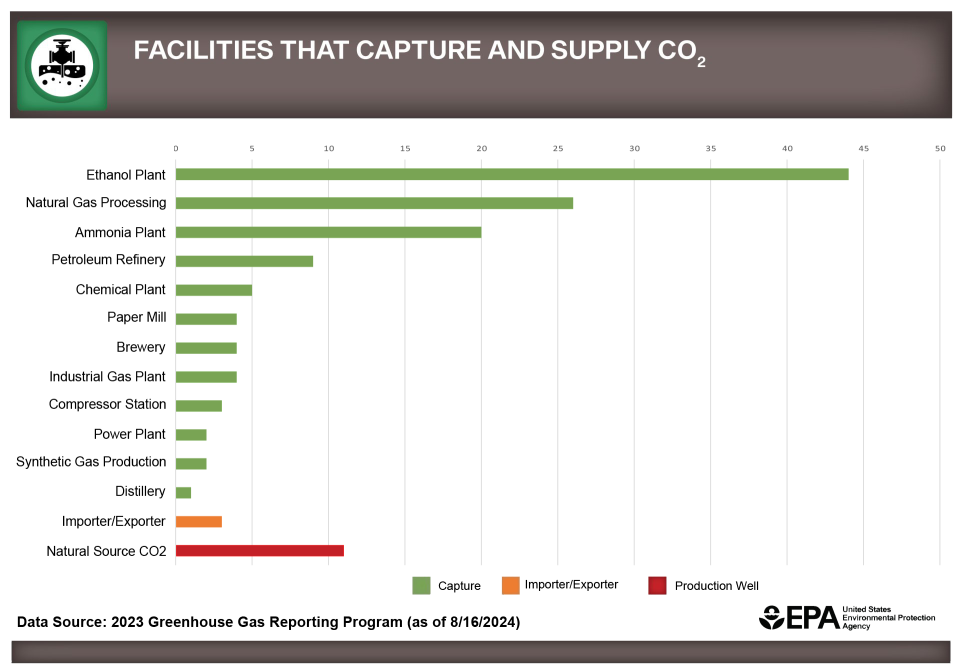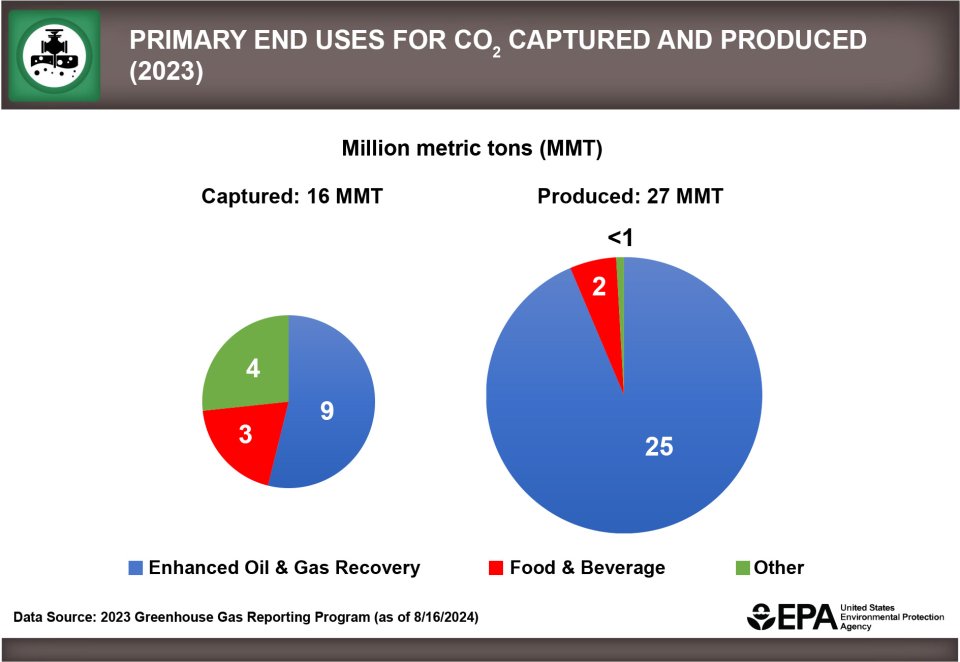Supply, Underground Injection, and Geologic Sequestration of Carbon Dioxide
EPA's Greenhouse Gas Reporting Program (GHGRP) collects key information regarding the supply, underground injection, and geologic sequestration of carbon dioxide (CO2) in the United States.
- Overview of Relevant GHGRP Subparts
- Data Highlights: Supply of CO2 (Subpart PP)
- Data Highlights: Geologic Sequestration of CO2 (Subpart RR)
- Data Highlights: Injection of CO2 (Subpart UU)
Overview of Relevant GHGRP Subparts
Greenhouse gas (GHG) data from these activities are reported under the following GHGRP subparts:
- Suppliers of CO2 (subpart PP) covers facilities that capture CO2 from industrial sources and processes or extract it from natural CO2-bearing formations for supply into the economy. It also covers facilities that capture and maintain custody of a CO2 stream in order to sequester or otherwise inject it underground. Capture refers to the initial separation and removal of CO2 from a manufacturing process or any other process (see 40 CFR Part 98 Subpart PP).
- Underground injection of CO2 (subpart UU) covers facilities not reporting under subpart RR that inject CO2 underground for the enhanced recovery of oil and natural gas, acid gas injection/disposal, carbon storage research and development (R&D), or for any other purpose other than geologic sequestration (see 40 CFR Part 98 Subpart UU).
- Geologic sequestration of CO2 (subpart RR) provides a mechanism for facilities to monitor and report to EPA amounts of CO2 sequestered. Facilities must submit and receive approval for a monitoring, reporting and verification plan (MRV plan) before they can report data under subpart RR. EPA MRV plan decisions can be found on the subpart RR page. Once the plan is approved, facilities report basic information on CO2 received for injection, data related to the amounts of CO2 sequestered, and annual monitoring activities (see 40 CFR Part 98 Subpart RR). Note that any subpart RR decision pertains only to subpart RR, and does not in any way replace, remove, or affect Underground Injection Control (UIC) permitting obligations.
- Geologic Sequestration of Carbon Dioxide with Enhanced Oil Recovery Using ISO 27916 (subpart VV) covers facilities not reporting under subpart RR that use the standard designated as CSA/ANSI ISO 27916:19 as a method of quantifying geologic sequestration of CO2 in association with enhanced recovery operations for oil and other hydrocarbons. Subpart VV is effective as of January 1, 2025.

Data Highlights: Suppliers of CO2 (Subpart PP)
Supply of CO2 (Subpart PP)a
Amount (MMT)b,c
| Metric | 2016 | 2017 | 2018 | 2019 | 2020 | 2021 | 2022 | 2023 |
|---|---|---|---|---|---|---|---|---|
| Total Supply of CO2 | 55.90 | 59.90 | 58.40 | 61.30 | 44.70 | 43.98 | 46.80 | 42.90 |
| CO2 captured (industrial sources) | 17.20 | 19.20 | 19.70 | 22.30 | 17.50 | 16.90 | 18.10 | 16.10 |
| CO2 produced (natural sources) | 38.70 | 40.70 | 38.70 | 39.00 | 27.20 | 27.08 | 28.70 | 26.80 |
aThe GHGRP also collects data from importers and exporters of carbon dioxide. These data are not provided in the table but these reporters can be identified through FLIGHT.
b Million Metric Tons
cAs of August 16, 2024.
Totals may not sum due to independent rounding.
Primary End Uses of Captured and Produced CO2 (Subpart PP)
Amount (MMT)a,b
| Metric | 2016 | 2017 | 2018 | 2019 | 2020 | 2021 | 2022 | 2023 |
|---|---|---|---|---|---|---|---|---|
| Total Supply of CO2 | 55.90 | 59.90 | 58.40 | 61.30 | 44.70 | 43.98 | 46.80 | 42.90 |
| Enhanced oil and gas recovery | 46.70 | 49.60 | 48.40 | 52.10 | 35.21 | 35.09 | 36.68 | 33.76 |
| Food and Beverage | 4.64 | 4.58 | 4.13 | 4.87 | d | 4.99 | 5.00 | 4.59 |
| Otherc | 4.64 | 5.72 | 5.85 | 4.26 | 4.53 | 3.94 | 5.02 | 4.53 |
aAs of August 16, 2024
b Million Metric Tons
cIncludes cleaning and solvent use, fumigants and herbicides, transportation and storage of explosives, fire-fighting equipment, industrial and municipal water/wastewater treatment, pulp and paper, metal fabrication, greenhouse plant growth, geologic sequestration, and unknown (which may include enhanced oil and gas recovery).
dAt this time, the aggregation does not meet EPA's criteria for ensuring that CBI is protected.
Totals may not sum due to independent rounding.
Ethanol, natural gas, and ammonia production are among the top three industrial facility types that capture CO2 for supply into the economy. The chart below shows counts of facility types that capture and supply CO2.

In 20231, most of the CO2 captured from industrial processes (54 percent) and nearly all of the CO2 produced from natural sources (94 percent) was used for enhanced oil and gas recovery. Food and beverage manufacturing is the second most common end use, followed by other end uses such as pulp and paper manufacturing, fire-fighting equipment, and metal fabrication.
1 As of 8/16/2024.

Totals may not sum due to independent rounding.
* Includes cleaning and solvent use, fumigants and herbicides, transportation and storage of explosives, fire-fighting equipment, industrial and municipal water/wastewater treatment, pulp and paper, metal fabrication, greenhouse plant growth, geologic sequestration, and unknown (which may include enhanced oil and gas recovery).
Note that some CO2 suppliers reported the primary end use for captured or produced CO2 as "unknown." It is believed that the quantities reported by CO2 suppliers as "unknown" account for the difference between CO2 received for enhanced oil and gas recovery and CO2 supplied for enhanced oil and gas recovery.
Data Highlights: Geologic Sequestration of CO2 (Subpart RR)
After capture, CO2 is compressed and then transported to a site where it is injected underground for permanent storage (also known as “geologic sequestration”). CO2 is commonly transported by pipeline, but it can also be transported by train, truck, or ship. Geologic formations suitable for sequestration include depleted oil and gas reservoirs, deep saline formations, and unmineable coal seams.
Geologic Sequestration of CO2(Subpart RR)a
CO2 reported as sequestered in the reporting year (MMT)b
| 2016 | 2017 | 2018 | 2019 | 2020 | 2021 | 2022 | 2023 |
|---|---|---|---|---|---|---|---|
| 3.09 | 5.96 | 7.66 | 8.33 | 6.80 | 6.95 | 8.01 | 16.30 |
|
Cumulative CO2 reported as sequestered in all reporting years (MMT)b |
63.16 | ||||||
aAs of August 16, 2024
b Million Metric Tons
ER = enhanced recovery and D = disposal
The facility-level sequestration data reported under subpart RR are publicly available on the EPA's Facility-Level Information on Greenhouse gases Tool (FLIGHT). On the FLIGHT page, users can select the "Geologic Sequestration of CO2 (RR)" option from the Facility Type dropdown and click "Apply Search" to see facility-level data. View annual monitoring reports submitted by facilities who report data under subpart RR.
Data Highlights: Injection of CO2 (Subpart UU)
After CO2 is captured or produced, it can be compressed and transported to a site where it is injected underground. Some facilities both capture or produce CO2 and inject it underground onsite.
The primary use of carbon dioxide is for enhanced oil and gas recovery. Enhanced oil and gas recovery helps to mobilize oil and gas in underground hydrocarbon reservoirs, thereby increasing production. While most CO2 captured or produced is supplied to facilities that conduct enhanced oil and gas recovery, a smaller portion is injected underground for other purposes.
Injection of CO2(Subpart UU)
CO2 received in the reporting year (MMT)a,b
| Metric | 2016 | 2017 | 2018 | 2019 | 2020 | 2021 | 2022 | 2023 |
|---|---|---|---|---|---|---|---|---|
| CO2 received for enhanced oil and gas recovery | 44.00 | 50.30 | 49.00 | 48.70 | 36.40 | 31.30 | 31.80 | 26.7 |
| CO2 received for other purposes | 0.76 | 0.92 | 0.49 | 0.57 | 0.62 | 0.59 | 0.66 | 0.70 |
| Total CO2 received | 44.80 | 51.30 | 49.50 | 49.20 | 37.00 | 31.90 | 32.50 | 27.40 |
aAs of August 16, 2024
b Million Metric Tons
Totals may not sum due to independent rounding.
